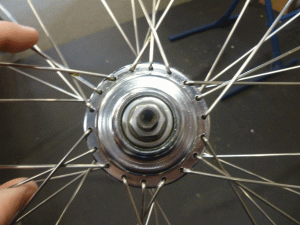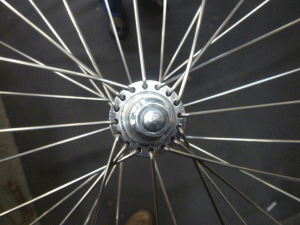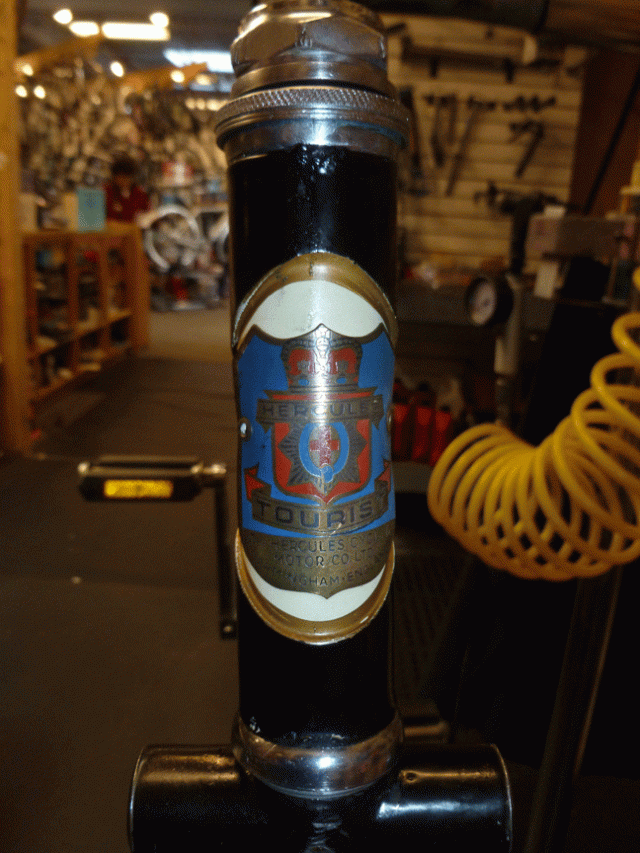It’s a good feeling to ride atop a bicycle wheel that you have built yourself, to know that you have successfully combined an inconsequential mass of hub, spokes and rim into a critical component good for thousands of trouble-free miles.
As a bicycle mechanic, it’s an even better feeling to know that other people rely on the strength of the wheels you build for their own safety.
But as important as durability and safety are, the reasons I began building wheels in the late 1970s were to 1) prove to myself that I could do it and 2) to create something I couldn’t easily buy.
Once I created a set of wheels that were later stolen, along with the rest of my sister’s Sekai 2400 bicycle. She never saw the frame again, but we got the wheels back because a mechanic in Columbia, Missouri, recognized a pretty unusual build: Hi-E hubs tied to Weinmann Concave rims.
For people who understand the divergent design intentions of these products, my apologies.
Most of my wheels featured a three-cross or four-cross design, which is identified by following a single spoke from the hub and counting the number of other spokes that it crosses. Pretty standard stuff.
Occasionally, I’d build a radial (no cross) front wheel or a rear wheel with a different cross pattern on one side of the hub than the other, usually for my own use.
One of my favorite builds comprised a Sturmey-Archer 3-speed hub, DT spokes and (yes, once again) a Weinmann Concave rim built up with a three-cross pattern on the drive side and a radial pattern on the other.
That poor old Raleigh International never saw the wheel—or the cantilever braze-ons—coming.
Hey, it’s not like they were steel rims
I liked the aluminum Concaves because they were sturdy. If they were any heavier, I could have specified steel rims, except that high-quality, lightweight steel rims didn’t (and don’t) exist and, with the rim brakes available at the time, the steel rims that did exist made stopping in wet conditions an iffy thing at best.
Back in the 1970s, a bicycle shop had to have a human wheel builder. Pre-built wheels were stocked only for children’s bikes and entry-level adult bikes.
Today, shops sell a lot of high-end machine-built wheels that weren’t available back then, and the biggest reason they do it is pretty simple: no labor costs. Without a spoke tension gauge, and sometimes even with it, you have a hard time telling the difference between handbuilt and machine-built wheels when you’re standing on the shop floor.
Purists, among which I count myself, will tell you the quality of a handbuilt wheel reveals itself after a lot of hard miles on the road. They keep their alignment, mile after mile. Unfortunately, bicycle shops expect you to pay for your wheels before that quality reveals itself: another reason machine-built wheels are so successful in the marketplace.
Prepare to enter the Woo Zone
So when you see a truly unusual set of wheels these days, you’re likely to find yourself talking to people who build wheels for their own bicycles. And that’s true even when the rims are steel.
Case in point: the wheels for a Hercules bicycle—possibly a 60-year-old machine—built by Bushwhacker mechanic Robert Woo.
Originally, a Hercules featured a rear wheel with 40 spokes and a front wheel with 32 spokes. However, because of the condition of the original rear hub, Robert substituted a 36-hole unit in the back and laced both hubs to new steel rims—I say because he favored authentic rims to authoritative braking.
Here’s where the hand building is obvious. The spokes in most bicycle wheels depart the hub for the rim in one of two directions: either forward or backward. But the spokes in these wheels go in one of three directions: forward, backward or radially.
Nobody sets up a machine to build wheels like this for a three-speed bicycle. Moreover, the exact “crow’s feet” pattern also varies with the number of holes in the hub.

Not your usual three-speed wheel. Note the tight three-spoke groupings; if this were a heavily dished wheel, you'd need four different lengths of spokes to build it.
First, take a look at the 36-hole rear hub. You’ll see 6 groups of 3 spokes arranged around the near hub flange. 6 times 3 equals 18. Double that total to account for the other hub flange, and you end up with 36 spokes. Perfect.
Now take a look at the 32-hole front hub. Remember, you can’t evenly divide 32 by 3. So you end up with 4 groups of 3 spokes on the near flange (4 times 3 equals 12) and four radial spokes filling in the missing holes (4 plus 12 equals 16). Double that and you’ve successfully filled the hub.

Modified crow's foot pattern for the 32-hole front hub. Notice the radial spokes separating groups of three spokes.
And you’ve built both wheels this way for no particular reason other than you can, which in an increasingly automated universe may be the best reason of all.
Woo, woo!


Informative !!, Thanks